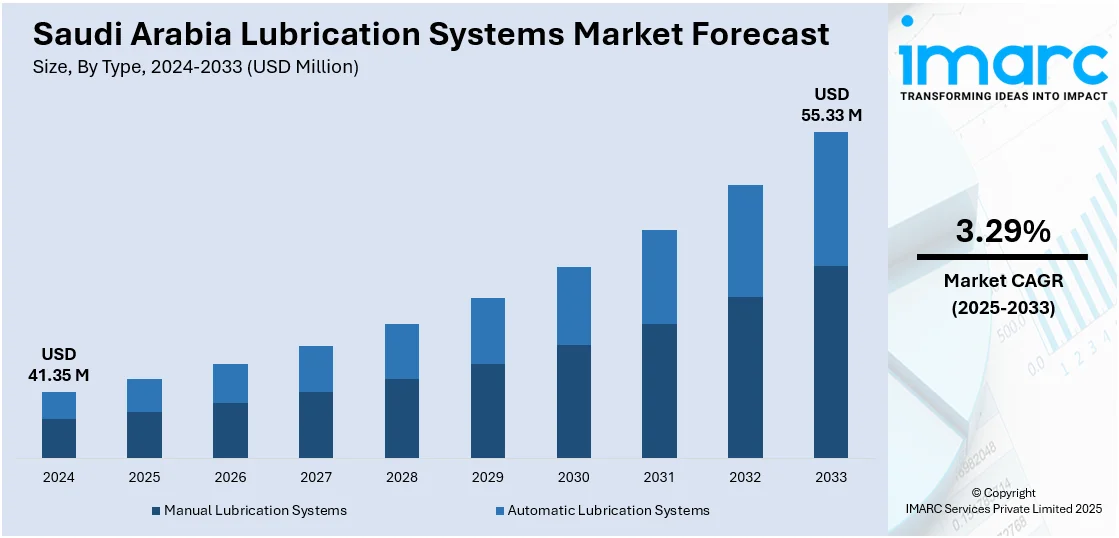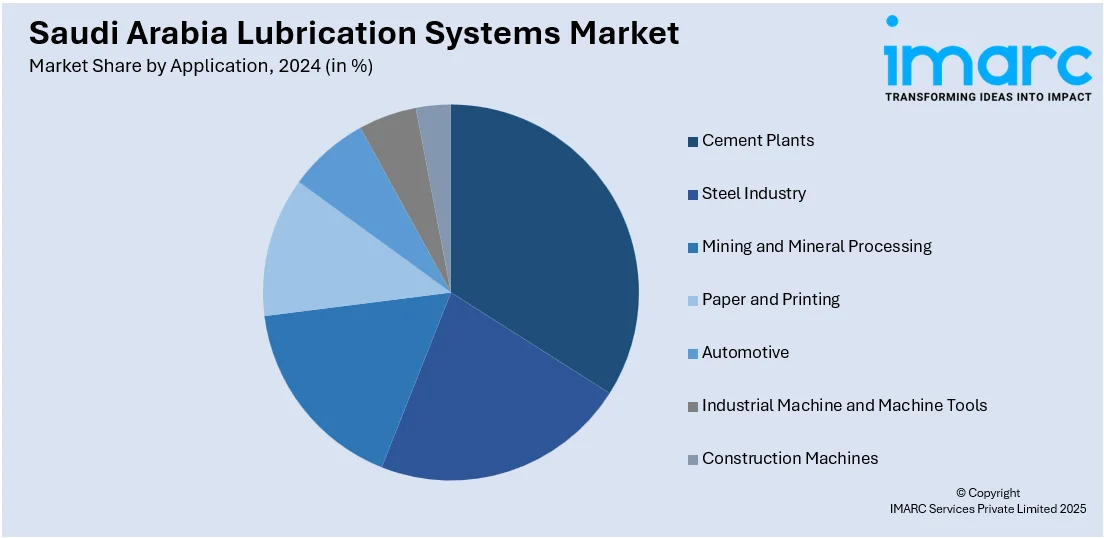
Saudi Arabia Lubrication Systems Market Size, Share, Trends and Forecast by Type, Application, Process, and Region, 2025-2033
Saudi Arabia Lubrication Systems Market Overview:
The Saudi Arabia lubrication systems market size reached USD 41.35 Million in 2024. Looking forward, IMARC Group expects the market to reach USD 55.33 Million by 2033, exhibiting a growth rate (CAGR) of 3.29% during 2025-2033. The market is growing steadily, driven by increasing industrial activity, expanding oil and gas operations, and rising demand for efficient machinery maintenance solutions. Technological advancements and government support for industrial diversification are also boosting adoption. These trends are shaping a competitive landscape, contributing significantly to the overall Saudi Arabia lubrication systems market share.
|
Report Attribute
|
Key Statistics
|
|---|---|
|
Base Year
|
2024 |
|
Forecast Years
|
2025-2033
|
|
Historical Years
|
2019-2024
|
| Market Size in 2024 | USD 41.35 Million |
| Market Forecast in 2033 | USD 55.33 Million |
| Market Growth Rate 2025-2033 | 3.29% |
Saudi Arabia Lubrication Systems Market Trends:
Expansion of the Oil & Gas Sector
Saudi Arabia’s dominant oil and gas sector drives significant demand for high-performance lubrication systems. With continuous investment in exploration, refining, and petrochemical infrastructure, there is a growing need for efficient lubrication to enhance equipment reliability in harsh desert environments. These systems reduce machinery wear, prevent operational downtime, and ensure safety compliance. The push to boost production capacity and integrate advanced technologies makes automated lubrication essential in maintaining uninterrupted operations. As Saudi Aramco and other energy firms invest in sustainability and efficiency, lubrication systems become vital in supporting equipment performance while reducing maintenance costs. This trend strongly influences the demand for centralized and automatic lubrication systems in the country’s core energy sector.

Emphasis on Equipment Efficiency and Lifecycle Management
Across sectors like construction, mining, and heavy industry, maintaining machinery efficiency and extending asset life is a top priority. Lubrication systems play a key role in reducing friction, preventing component failure, and maintaining peak performance. With capital-intensive machinery operating in high-temperature and dusty conditions, timely and accurate lubrication is critical. Automated systems ensure consistent maintenance, eliminate manual errors, and reduce the frequency of servicing. This contributes to lower operational costs and better return on investment. As businesses in Saudi Arabia adopt lifecycle management strategies to improve asset utilization and reduce downtime, the use of advanced lubrication technologies becomes a strategic necessity for long-term industrial sustainability.
Environmental Regulations and Sustainability Goals
Saudi Arabia is advancing environmental stewardship through national initiatives that promote industrial efficiency and reduce emissions, thereby driving the Saudi Arabia lubrication systems market growth. Lubrication systems are vital in aligning with sustainability goals, as they minimize oil waste, reduce leakages, and support clean operations. The introduction of environmentally acceptable lubricants (EALs) and biodegradable options is becoming more common, especially in sensitive areas. Automated systems further contribute by optimizing lubricant use and preventing over-application. As regulatory frameworks tighten and corporate ESG practices gain traction, industries are increasingly prioritizing sustainable maintenance. This transition is leading to greater adoption of lubrication systems that not only support environmental compliance but also reduce costs, improve efficiency, and demonstrate commitment to responsible industrial practices.
Saudi Arabia Lubrication Systems Market Segmentation:
IMARC Group provides an analysis of the key trends in each segment of the market, along with forecasts at the country and regional levels for 2025-2033. Our report has categorized the market based on type, application, and process.
Type Insights:
- Manual Lubrication Systems
- Automatic Lubrication Systems
- Single-line Lubrication Systems
- Dual-line Lubrication Systems
- Multi-line Lubrication Systems
- Series Progressive
- Circulating Oil
- Oil and Air
The report has provided a detailed breakup and analysis of the market based on the type. This includes manual lubrication systems and automatic lubrication systems (single-line lubrication systems, dual-line lubrication systems, multi-line lubrication systems, series progressive, circulating oil, and oil and air).
Application Insights:

- Cement Plants
- Steel Industry
- Mining and Mineral Processing
- Paper and Printing
- Automotive
- Industrial Machine and Machine Tools
- Construction Machines
A detailed breakup and analysis of the market based on the application have also been provided in the report. This includes cement plants, steel industry, mining and mineral processing, paper and printing, automotive, industrial machine and machine tools, and construction machines.
Process Insights:
- Dry Sump Lubrication
- Wet Sump Lubrication
A detailed breakup and analysis of the market based on the process have also been provided in the report. This includes dry sump lubrication and wet sump lubrication.
Regional Insights:
- Northern and Central Region
- Western Region
- Eastern Region
- Southern Region
The report has also provided a comprehensive analysis of all the major regional markets, which include the Northern and Central Region, Western Region, Eastern Region, and Southern Region.
Competitive Landscape:
The market research report has also provided a comprehensive analysis of the competitive landscape. Competitive analysis such as market structure, key player positioning, top winning strategies, competitive dashboard, and company evaluation quadrant has been covered in the report. Also, detailed profiles of all major companies have been provided.
Saudi Arabia Lubrication Systems Market Report Coverage:
| Report Features | Details |
|---|---|
| Base Year of the Analysis | 2024 |
| Historical Period | 2019-2024 |
| Forecast Period | 2025-2033 |
| Units | Million USD |
| Scope of the Report | Exploration of Historical Trends and Market Outlook, Industry Catalysts and Challenges, Segment-Wise Historical and Future Market Assessment:
|
| Types Covered |
|
| Applications Covered | Cement Plants, Steel Industry, Mining and Mineral Processing, Paper and Printing, Automotive, Industrial Machine and Machine Tools, Construction Machines |
| Processes Covered | Dry Sump Lubrication, Wet Sump Lubrication |
| Regions Covered | Northern and Central Region, Western Region, Eastern Region, Southern Region |
| Customization Scope | 10% Free Customization |
| Post-Sale Analyst Support | 10-12 Weeks |
| Delivery Format | PDF and Excel through Email (We can also provide the editable version of the report in PPT/Word format on special request) |
Key Questions Answered in This Report:
- How has the Saudi Arabia lubrication systems market performed so far and how will it perform in the coming years?
- What is the breakup of the Saudi Arabia lubrication systems market based on type?
- What is the breakup of the Saudi Arabia lubrication systems market on the basis of application?
- What is the breakup of the Saudi Arabia lubrication systems market on the basis of process?
- What is the breakup of the Saudi Arabia lubrication systems market on the basis of region?
- What are the various stages in the value chain of the Saudi Arabia lubrication systems market?
- What are the key driving factors and challenges in the Saudi Arabia lubrication systems market?
- What is the structure of the Saudi Arabia lubrication systems market and who are the key players?
- What is the degree of competition in the Saudi Arabia lubrication systems market?
Key Benefits for Stakeholders:
- IMARC’s industry report offers a comprehensive quantitative analysis of various market segments, historical and current market trends, market forecasts, and dynamics of the Saudi Arabia lubrication systems market from 2019-2033.
- The research report provides the latest information on the market drivers, challenges, and opportunities in the Saudi Arabia lubrication systems market.
- Porter's five forces analysis assist stakeholders in assessing the impact of new entrants, competitive rivalry, supplier power, buyer power, and the threat of substitution. It helps stakeholders to analyze the level of competition within the Saudi Arabia lubrication systems industry and its attractiveness.
- Competitive landscape allows stakeholders to understand their competitive environment and provides an insight into the current positions of key players in the market.
Need more help?
- Speak to our experienced analysts for insights on the current market scenarios.
- Include additional segments and countries to customize the report as per your requirement.
- Gain an unparalleled competitive advantage in your domain by understanding how to utilize the report and positively impacting your operations and revenue.
- For further assistance, please connect with our analysts.
 Request Customization
Request Customization
 Speak to an Analyst
Speak to an Analyst
 Request Brochure
Request Brochure
 Inquire Before Buying
Inquire Before Buying




.webp)




.webp)












